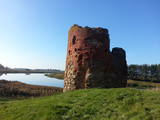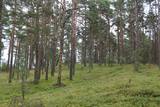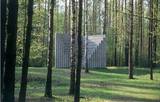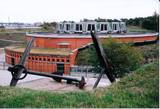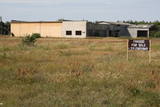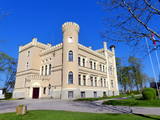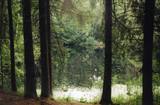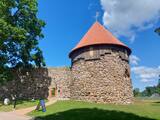| Нo | Название | Описание |
|---|---|---|
|
Опытные пчеловоды знакомят со своим пчеловодческим хозяйством и ежедневными обязанностями пасечника. Можно попробовать и приобрести навынос мед, а также различные медовые смеси, получив вдобавок к этому высушенные холодным способом ягоды. |
||
|
Boutique Hotel Altenburg mājo vairāk nekā divus gadsimtus senā koka ēkā, kas ir viena no ievērojamākajām Talsu vecpilsētas arhitektūras pērlēm. Kādreiz gandrīz pamesta un nolaista, šī ēka piedzīvojusi rūpīgu restaurāciju, atgūstot savu šarmu un vēsturisko stāju. Viesnīcas interjers ir harmonisks līdzsvars starp wabi-sabi pieeju, rustikālu eleganci un dabiskām faktūrām — te dominē koks, akmens un lins. Katrā telpas detaļā jūtama pārdomāta izvēle un cilvēciska piesaiste. Dizaina koncepciju radījis Roalds Cinis, bet apdari papildina vietējo meistaru roku darbs: “Ciparnīcas” keramikas trauki, darināti pledi un Latvijas tējas. Viesiem piedāvāti seši divvietīgi numuri, koplietošanas virtuve un mājīgs salons, kā arī klusas lasīšanas vietas ar grāmatām un mazs vīna pagrabiņš. Boutique Hotel Altenburg atspoguļo lēnās dzīves filozofiju — tā ir vieta nesteidzīgai atpūtai, klusumam un pievēršanās sev. |
||
|
Хутор Elkas kalna saimniecība расположен на вершине живописной горы Элкас ‒ в том месте, где начинается Гауя. Травяные чаи, разные виды березового сока, варенье и другие полезные для здоровья лакомства из собранных на местных лугах и выращенных в саду растений. Также предлагаются природные мастерские и пикники под открытым небом. |
||
|
You will find the nice and quiet Kuusiku Nature Farm on the edge of the beautiful Lahemaa National Park by Lake Viitna Pikkjärv. The Kuusiku Farm offers traditional farm bread. |
||
|
The Capital of Saaremaa island. Popular resort. The Town Hall is built in the style of Baroque. |
||
|
Пилтене – это один из самых малых и древних городов Латвии. В исторических источниках Пилтене первый раз было упомянуто в 1295-м году, а стутус города был получен уже в 1557-м году. В период с 14-й по 16-й века Пилтене было административным центром Курляндского епископства. На исторических улицах, которые полукругом окружают руины замка, сохранилась деревянная застройка первой половины 19-го века. Пилтенский епископский замок был построен на рубеже 13-14 веков и использовался до 16-го века. До сего дня сохранился только фундамент и фрагменты башни на берегу Вецвенты. |
||
|
Возможно, что церковная гора Бакю была древним культовым местом. Сегодня она представляет собой дюнное возвышение, которое лишь немногим превышает по размерам остальные дюны. Об этом месте ходит легенда о провалившейся церкви. Места с легендами о провалившейся церкви могут свидетельствовать о том, что на конкретном месте когда-то находилось какое-нибудь христианское или языческое место для молитвы. (Источник: Роя ТИЦ) |
||
|
Трактир Kaali на протяжении долгих лет предлагает своим гостям лучшие блюда и напитки эстонской и сааремской кухни, приготовленные из местных продуктов, а также знакомит с культурой и историей острова. Посетители музея и метеоритного кратера Каали могут здесь вкусно перекусить. |
||
|
Бывшая Кемерская купальня – в 19 веке
здесь находилось деревянное ванное
помещение, а в 1924 г. для лечебных грязей был
построен комплекс зданий в стиле
классицизма. После Второй мировой войны на
этой базе была создана курортная поликлиника
"Кемери". Сегодня уникальный комплекс, хотя и
приватизирован, напоминает жуткие трущобы.
С западной стороны комплекса установлен
памятник великому русскому врачу-
физиологу Ивану Павлову, на который также
не хватает времени и заботливых человеческих
рук.
|
||
|
Das Museum vom Zentrum Europas. Gegründet vom litauischen Bildhauer Gintaras Karosas. Mehr als 100 von Künstlern aus den 33 Ländern errichtete Installationen sind unter freiem Himmel ausgestellt. |
||
|
Schon seit der früheren Zeiten – ein Platz von der militärischen und strategischen Bedeutung. Für den Schutz des Hafens von Klaipeda wurde 1866 von preussischer Militär den Bau einer Festung angefangen. Im Laufe des 2.Weltkriegs wurde die Festung in die Luft gesprängt. Die Renovierung begann 1979. |
||
|
В задачу 15-й радиотехнической бригады в Сарайки входила пограничная охрана морского берега. В настоящее время объект находится в собственности Министерства обороны, где расположена учебная база 17-го батальона земессардзе.
|
||
|
Расположено на главной улице Ливан. Предлагается домашняя кухня и латышские блюда. Латышская кухня: Картофельные блины, холодный суп, перловая и ячменная каша, свиные ребрышки с кислой капустой, хлебный суп. Особое блюдо: «Камни Дубны и Даугавы» - картофельные клецки с творожной начинкой в сметанном соусе. |
||
|
Господский дом поместья Гарсене (неоготический стиль) по образцу виллы, увиденной в Германии, строился с 1856 по 1860 год. С 1860 до 1920 год господская усадьба находилась в собственности баронского родаБудбергов-Беллинсгаузенов. В 1885 году господский дом расширили, пристроив еще одно крыло. В 1939 - 1940 годах здание перестроили под школу, в торжественном открытии которой в своей последней официальной поездке по Латвии 2 июня 1940 года участвовал K. Ульманис. В комплекс господской усадьбы входят другие хозяйственные постройки и парк. В наши дни в господском доме размещается Гарсенская начальная школа. Здесь выставлена экспозиция, посвященная роду баронов, истории школы и Гарсене. В качестве экспоната представлена горшечная печь! Около господской усадьбы берут свое начало Гарсенские природные тропы – «Культурно-историческая тропа», «Прогулочная тропа барона» и др. Перед тем, как отправиться на тропу, необходимо купить билет в здании господской усадьбы Гарсене. Перед господской усадьбой установлен памятный камень в часть агрохимика и профессора Петериса Кулитана (1878 - 1951).
|
||
|
Первые сведения о святом источнике в Тирзе относятся к середине 18 века, однако источник использовался значительно раньше. После омовения или забора воды источнику оставляли пожертвования. В первой половине 19 века барон Тирзе и церковь начали борьбу с этой языческой традицией, однако не очень успешно. Над источником возведен навес, и люди по сей день приезжают к нему за водой. |
||
|
This is the thickest European wild apple tree in Latvia. It is just lovely when it is blossoming.
|
||
|
Meklējamas Lizuma ciema dienviddaļā. Tās ir vienas no retajām vējdzirnavām (1880. g.), kas saglabājušās labā stāvoklī. Mūsdienās dzirnavas ir gleznotājas Ilonas Brektes īpašums. |
||
|
Another area where the manifestations water-soluble lime in the earth can be found. As the lime dissolves, there are empty areas underground which eventually collapse. To the East of Skaistkalne is a leisure area where dry and full holes of various sizes can be found.
|
||
|
В 1342-м году на самом большом острове Алуксненского озера – острове Марияс (Пилссала) Ливонский орден построил укрепленный замок, соединенный с берегом озера подъемным деревянным мостом длиной 120 м. У орденского замка было несколько форбургов, замок регулярно усовершенствовался и расширялся вплоть до конца 17-го века. Это был один из самых больших замков в восточной части территории, находящейся под управлением Ливонского ордена. Похожие замки были в Вастселийне и Изборске. В это время вокруг замка были возведены оборонительные валы. Орденский замок просуществовал до Северной войны, когда разбитые шведские войска взорвали его центральную часть и сдались, а русские войска его полностью разрушили. Сегодня о событиях того времени свидетельствуют руины на острове, который с берегом озера – центром Алуксне и горой Темпля – соединяется двумя деревянными мостами. На эстраде возле руин замка проходят различные публичные мероприятия. |
||
|
Находится на обочине шоссе Екабпилс - Резекне (A 12), в живописном месте около пруда, где можно ловить окуней, щук, линей и карпов. Предлагаются рыбные блюда и блюда восточной кухни. |
||







